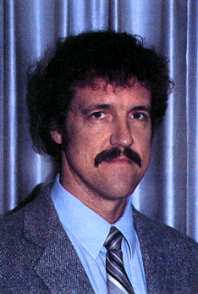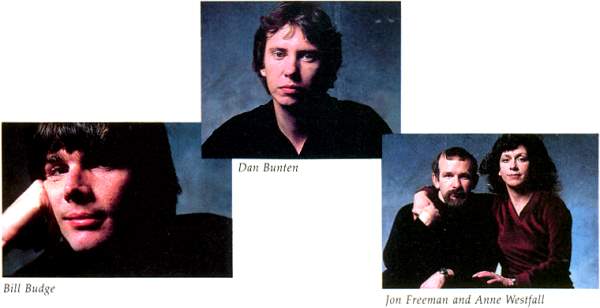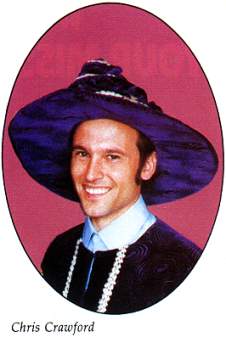BIRTH
OF A
COMPUTER GAME
Sharon Darling, Research Assistant
OF A
COMPUTER GAME
Sharon Darling, Research Assistant
Five of the world's best computer game designers talk about how they create their games.
Chris Crawford, Jon Freeman, Bill Budge, Bruce Carver, and Dan Bunten-some of the most famous names in computer game design-don't consider themselves master programmers. It might be more accurate to call them artists who also know how to program a computer.
"I wouldn't characterize myself as a brilliant programmer; I would characterize myself as a competent programmer, and that's about all," says Crawford, the designer behind such critically acclaimed games as Eastern Front and Excalibur. "Great games don't spring from brilliant programming," he adds. "Brilliant programming can only take you a very short distance. The first real trick is at the design stage."
Budge, who created Pinball Construction Set, an innovative, seminal game, concurs. "It's important not to be just a programmer right now," he says, "and I think the most unique thing I do is in the area of designing, although I also think I'm lucky that I'm a good programmer, so I don't necessarily have to depend on other programmers."
Another vote for the importance of design comes from Bruce Carver, author of the games Beach Head and Raid Over Moscow. "A programmer has to be some kind of artist in addition to being just a raw programmer," he says. "If he can't sketch and draw pictures, he has to rely on an outsider to help him program the game if he wants it to look good.
"And the problem with that is that an artist just sees the picture in his mind, he doesn't really see things interacting from a programmer's point of view. So we feel that a good programmer has to be three or four different people at the same time if he wants to do this game and make it very cohesive."
While the basic idea for a game may come from anywhere-the name Raid Over Moscow sprang up on a trip from Las Vegas to Carver's home in Utah-from that point on, the process becomes very detailed and takes months to complete. "Regardless of how it [an idea] starts, a premise has to be developed," Carver says. "So what we [the design team at Access Software] do is sit down in a meeting, and we talk about this idea that we think has potential."
Moving from the talking stage to the completed game involves many steps, and the game may even be shelved at some point along the way because the original idea just didn't lend itself to a finished product.
"We're firm believers in the storyboard type of approach," says Bunten, whose software development firm, Ozark Softscape, turned out the hit games M.U.L.E. and Seven Cities of Gold. Using such a system means that "you've worked out at that point most of the key conceptual elements, and you work out what the driving motivation is that the player should experience when he's playing," Bunten says. "What's his goal-what is he after, what does he want to get out of this experience? That's one of the first things we want to get. Then we'll figure out, based on that, how the environment has to support the image."
Carver looks for a sweaty-palm feeling. "There's a lot of thought given to what's going to be the most playable screen. You want to take that user to the point where his hands start getting sweaty, and he's always making decisions on what he's going to be firing at, or what he's going to do.
"If you just always have the same thing for him, he's going to get bored really quickly, so you make his mind work, you give him options.... We try to very subtly put those all through the game, so it's not really apparent, but it retains the interest for a long time."
Freeman, whose credits include Archon, Archon II: Adept, and Murder on the Zinderneuf, says he starts with an idea "that has become sufficiently clear and sufficiently compelling or attractive-whichever project is nagging me the most." From there, an outline is developed to chart the game's direction.
"We have a good idea where the game is going and what it will look like at the be ginning," Freeman says of his software team, Freefall Associates. "But there's a lot of finetuning that can only be done after the game has started to take concrete form.
"The design is not something cast in stone that has to be followed to the letter-it's more of a guideline. Many people who start have only a vague idea where they're going. We do have a pretty good idea where we're going, but that doesn't mean we don't run into blockades. We kick out ideas and throw out the bad ones."

Bruce Carver
Also, some games contain hidden lessons. "Some of the games I've done have had goals of teaching people about nature or warfare-specifically, the goal of quantitative factors versus false factors," Crawford says. "The point of the game Excalibur is leadership. I didn't set out to do a King Arthur game-I set out to do a game about leadership. And once you've chosen your goal, you choose a topic that is a theme for expressing your goal."
With Eastern Front, he adds, the goal was "to teach people the difference between fire power and military effectiveness-it was something that was bothering me. A lot of Americans have this problem in thinking that the more weapons you have, the more powerful you are."
In Seven Cities of Gold, Ozark Softscape embodied three different ideas, Bunten says. "One was that the world was big and enormous, and these people were really brave to head off into the total unknown. Second, interaction with the natives was a subtle kind of communication; there was always a language barrier. Third," he adds, "there was a moral dilemma built in. Just because you're big enough to take what you want, does that make it right to take it?"
At first, players who field tested the game would take all the goods and gold they could from natives. But soon the testers "began to discover that they didn't feel real good about themselves, so they would get to a point where they would build rules for themselves, like 'Well, I won't kill them unless they kill me first.' "
Sometimes, the hidden messages can be as subtle as not using sexist terms, as in Archon and Murder on the Zinderneuf. "Our documentation is not sexist, not even vaguely," Freeman says. "There are both male and female characters on the board in Archon, and female characters are not weaker than the male characters as a group. In Murder on the Zinderneuf, there are an equal number of [male and female] suspects, and there is a mix of detectives. Anybody can get killed, and anybody could have done it.
"That's all secondary to the point of having fun," he adds. "But it's in there by design."

If a would-be game designer wants to get started in the field, there are basically two approaches to take, at least judging by these five aces: either try to come up with something that breaks the mold as far as computer games are concerned, or start out using what's been done before as a guide.
Budge found success by improving on what had come before. "The way I got started was by not trying to do anything original at all," he recalls. "I wanted to learn how to write videogames. I bought an Apple about five years ago and just went to arcades and copied the games that I saw." He adds that his main interest at the time was in creating "neat pictures and neat sounds."
A really good game, he says, would turn the player into a hacker. "You should provide environments where it's fun to put together things that are structured on a computer, but you don't have all the junk that you have when you're programming. You sort of restrict people to doing things that are like videogames, or pictures and sound, and take away all the busywork part."
Toward that end, a project he is working on now is a construction set to build construction sets. "That's a very difficult program to write, and I could never have written that before Pinball. After I did Pinball, it seems like there's some faint chance." He also adds that if he hadn't started out the way he did, "I wouldn't be qualified to take the next step."
The environment for that project, which he says will take several years to complete, "is the sort where you can just play and not worry about the consequences of every single mistake. You can mix and match, you don't have to write something totally new, you can take something from Pac-Man and take a piece from Donkey Kong and make it work."
Oddly, Budge doesn't like to play arcade and videogames very much. In fact, he says it was "sheer torture" to play pinball steadily for months while working on his construction set. "There are other people who are into games and are better at it than I am, so I had to figure out ways to get around the gaming, but I still wanted to create things that were like videogames," he says.
Bunten also thinks taking a lesson from what's been done by others is useful for new designers. "Typically, my first game was a knock-off of someone else's game, and it was an enhancement of things that I thought were needed. You've got to build some experience just with the medium and what is possible, before you can jump off into some new territory.
"As long as it doesn't violate any copyright, it's probably a good way to get started. Somebody said there's nothing new under the sun, and there probably isn't."
Carver feels beginning designers need to realize that the process is not all fun and games. "It's not something that's as glamorous as it might sound," he says. "There are times when I want to leave so bad-I tend to get really grouchy-but I know if we're going to get it finished in, say, five months, then I have to stay and get the work done."
He agrees that "if you use other people's stuff, you'll get into a mold and you can't really get out. I find I have to consciously work on changing the things I do, otherwise I'll tend to do them the way I did them before, and the game will tend to have the same feel that it had before."
Crawford feels the most important consideration in game design is something he calls "artistic honesty." Far too many people, he adds, are writing programs that are imitations of other games. "They say 'Well, I'm going to do games!' Then they say, 'Well, what kind of games do I like right now? Well, I sure liked Pac-Man-let me do a variation on that.' And that is just the wrong way to do it.
"The right way to do it is to ask yourself what is an important interest around the world, and then try to capture that attraction," he asserts.
Freeman also feels that some game designers have fallen into a rut. "I think there are all sorts of subjects and lots of techniques and lots of approaches that are available, that haven't been done. I think, on the other hand, that many designers are in a rut-they define their universe too narrowly, in my opinion," he says.
While these five designers may differ in their opinions on how best to approach game writing, there is one point on which they all agree: Right now, it's tough for anyone, no matter how good, to get a game published in today's volatile software market.
Perhaps Crawford says it most gently. "I will point out the sad truth. We have pretty much passed the period where hobbyists could put together a game that would have commercial prospect. It's much more difficult to break in, much less stay in. Right now, in November 1984, I would discourage anyone. If you want to do a game, do it for fun, but don't try to do game designs to make any money. The odds are so much against the individual that I would hate to wish that heartbreak on anyone."
